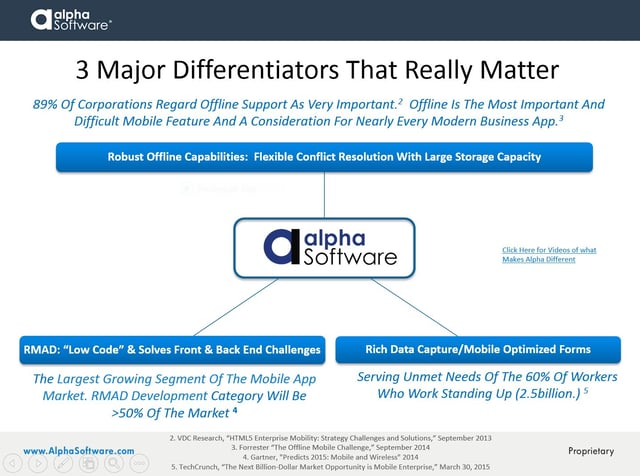We came across this are article recently in TheSeverSide.com and it dovetails in very well with the needs that we are seeing in the marketplace and why we built the Alpha Anywhere platform. This need revolves companies getting very interested in figuring out how they can build the large numbers of internal mobile apps and forms that have to be built to stay competitive. Companies need custom mobile apps that increase productivity and improve sales but need these apps fast.
By Jason Tee
By now, most enterprise-class organizations have figured out that going mobile is a necessity for competing in the modern marketplace to capture and keep customers. The average consumer assumes they will be able to interact with every business online, and now they expect to be able to carry out transactions on-the-go using their preferred mobile device. Big business has poured big money into mobilizing consumer-facing applications because the benefits are just too significant to ignore.
They are just now starting to spend money to create employee-facing mobile applications to improve business process, workflow, and employee productivity.
But 2015 may be the year businesses start taking a more introspective approach to mobile. Van Baker, a Gartner analyst who specializes in mobile and wireless, revealed this as a key trend for the coming year.
"Most organizations have applications that are customer facing. But the average enterprise has still only built about 10 mobile apps. They are just now starting to spend money to create employee-facing mobile applications to improve business process, workflow, and employee productivity."
The needs of these internal consumers will drive the direction of mobile development for enterprise in the near future.
What do business users want from a mobile app?
Unfortunately, employees often want more than they end up getting. Karsten Bugner Torp, technical director with Pernexus Systems, explained the conundrum this way, "People have a tendency to expect that you can do everything on a mobile device as on a desktop version of the same system. I think it's a fair assumption, given the mobile computing power that's walking around today. But it doesn't always make sense. A lot of office work requires a big screen. On the other hand, a mobile device has a lot of features like geo-location, photos, and video that you can do a lot of stuff with." How will enterprises deal with these expectations?
Behavioral engineering meets software engineering
Developers have to make tough decisions about what to make available on the mobile version of an internal enterprise application. Screen size, computing power, connectivity, and battery power all pose challenges. There are also some activities that simply don't lend themselves to mobile work. While manipulating a spreadsheet across dual monitors is clearly an office task, real-time chat and video-collaboration can be done on-the-go. As employees learn what's available and developers use ongoing feedback to adjust functionality and better support the work activities that typically take place using a mobile device, the road should get smoother.
Challenges of integrating enterprise backend with mobile
Baker pointed to integration as one of the most common pain points with mobilizing the enterprise workflow. "The part you see on the app itself is really just the user interface. A lot of the functionality in a mobile app doesn't come from the application running on the client device. It comes from the services that are delivering content or functionality to that application. If you are integrating with CRM, ERP, or your supply chain system, there's that integration issue that has to be overcome."
Third party vendors that provide push notifications, collaboration, and social network integration bring another set of issues to the table for linking the backend with mobile. "Invariably, development platforms and tool providers claim to have out of the box connectors for backend applications. Yes, they have the connectors, but they are set up to facilitate standard implementations for backend applications. Almost nobody has a standard implementation. The connectors end up just being the starting point. There's a lot of work to be done to get the APIs built to give you the level of access you need to be able to utilize that information."
Scaling is a problem—even for enterprise
From a big picture perspective, the challenges don't stop with how mobile users interact with the backend—it's also about how MANY do it at the same time. Protecting the enterprise backend from usage spikes requires additional forethought. Baker made the point that, when a new product is rolled out, every person on the sales team might want to check on the lead time simultaneously. The backend isn't prepared for that type of traffic. One solution is to host a subset of the data in the middleware tier. The mobile applications can interact with the subset and the data can then be synced with the backend at appropriate intervals.
23 Apr 2015
Alpha Anywhere's rapid mobile development platform provides the tools necessary to integrate with devices features such as video and geo-location. Produce secure mobile applications that continue to function in offline mode. With cross-platform support built into the package, you can quickly mobilize your enterprise workforce on any mobile device.
The core factors that distinguish Alpha Anywhere in terms of rapidly building offline-capable mobile apps and forms for business







Comment